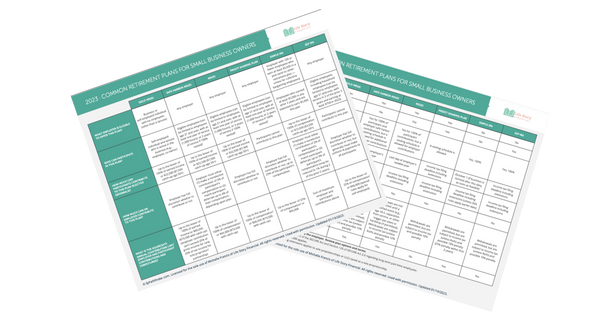What Retirement Plan is Best for Your Small Business?
- Michelle Francis

- Mar 8, 2023
- 5 min read
Updated: Oct 1

Welcome to Colorado in 2023, where many small business owners are required to offer a retirement plan to their employees. Some may see this as a chore with all the options out there and asking themselves, “What retirement offering do I choose?” However, I see this as an opportunity to empower and retain employees while helping them build their financial future.
Employee Retention and Tax Benefits
Retaining employees just makes financial sense. Research from the Society for Human Resource Management (SHRM) reported that on average it costs a company a whopping six to nine months of an employee's salary to replace the worker due to recruiting and training costs.
Beyond retention, starting a plan for your employees can decrease your business’s tax burden. Here are a few things to keep in mind:
Eligible employers may be able to claim a tax credit of up to $5,000, for three years, for the ordinary and necessary costs of starting a SEP, SIMPLE IRA or qualified plan like a 401(k) plan.
Costs include fees to set up and administer the plan and educate employees about the plan.
By adding an auto-enrollment feature to their plan, the business can claim an additional tax credit of $500 per year for those same three years.
If you make matching contributions to employees’ accounts, they may qualify as ordinary business expenses which can be deducted up to the annual corporate deduction limit of no more than 25% of covered payroll.
As the business owner, you can contribute a portion of your own salary to your personal retirement account that’s part of your business’s plan, reducing your taxable income and potentially moving you into a lower tax bracket.
Is Your Colorado Business Required to Offer a Retirement Plan?
In Colorado, any owner who has been in business for more than two years and has five or more employees needs a plan. There are deadlines to be aware of and you want to do yourself the favor of getting ahead of them, so you aren’t faced with a fine. Exemptions are available and will need to be submitted by June 30, 2023.
Employees | Deadline |
|---|---|
5-14 | June 30 |
15-49 | May 15 |
50+ | March 15 |
Before we review the various plan options, it’s important to note that all of these can include a Roth program. Why should you care about being able to save money to a Roth?
A Roth allows tax-free growth and withdrawals in retirement.
The money in a Roth is passed to your heirs tax-free.
You can contribute to a Roth at any age, even if you’re over full retirement age in the eyes of Social Security.
You don’t have to take a minimum required distribution money out of your Roth like you do at age 73 with tax-deferred accounts.
There are rules around who can save into a Roth, though. If you make more than $153,000 as a single person or $228,000 if you’re married, you’re not eligible.
Colorado Employers – Take Note About Colorado SecureSavings!
Our state is offering employers a savings plan called Colorado SecureSavings that includes a Roth IRA option. Something important to consider is that employees (including business owners) who earn a modified adjusted gross income (MAGI) of more than $139,000 or $206,000 married filing jointly are not able to participate in the state’s program. Also, employer contributions aren’t allowed, which means no tax credits for employers.
5 Employer Retirement Plans to Consider Beyond Colorado SecureSavings
So let’s get to it! The responsibility is being put on the owner to decide what makes the most sense for their business, their employees, and themselves. This is a great opportunity to show your employees that they can build their own financial future and boss themselves to retirement.
Here are the differences between the five types of employer retirement plans employers have access to if the Colorado SecureSavings option doesn't meet their needs.
401(k)
Any employer, including small businesses, can start this type of plan. It may be a good option if you want to write off matching contributions as a business expense and contribute a good portion of your own compensation to your account. All this while reducing your personal income, which is used to calculate your personal taxes.
It allows employees (including yourself) to save up to the lesser of 100% of earned income or $22,500, plus a $7,500 catch-up if you’re over age 50.
As the employer, you can decide whether to make contributions to employee accounts, including your own.
Total contributions (the employee’s contribution plus the employer’s match) can be made up to the lesser of 100% of compensation or $66,000.
SIMPLE IRA
It’s called “simple” for a reason—this type of plan is probably the easiest to set up. It might be a good choice is you run a small business with just a few employees. It has similar tax benefits, but here’s how it’s different from a 401(k) plan:
As the employer, you must make a nonelective annual contribution of at least 2% to every employee’s compensation (including your own);
OR match employees' salary deferrals up to 3% of compensation up to $15,500, with a $3,500 over age 50 catch-up.
SEP IRA
This type of plan allows the employer, but not employees, to save for retirement. It might be a good option if you run a solo business or a very small business with just a partner or a few employees, and you each have similar compensation.
The employer gets to decide whether or not to contribute to the plan each year.
The employer can contribute more to the plan than a SIMPLE IRA, up to the lesser of 25% or compensation or $66,000.
However, the contributions made must be equal for all employees, and all employees must receive a contribution.
SOLO 401(k)
Even as a solopreneur, you have access to a 401(k) plan which allows you contribute more than you can to a SIMPLE or SEP IRA plan. A Solo 401(k) allows both you and your spouse to participate.
As the business owner, you act as both the employer and employee when making contributions to the plan for yourself.
Just like a multiple-participant 401(k) plan, you can save up to the lesser of 100% of earned income or $22,500, plus a $7,500 catch-up if you’re over age 50, with total contributions of up to $66,000.
What’s the Next Step to Implement an Employer Retirement Plan?
If you’re feeling comfortable implementing these programs on your own, I recommend reviewing the above types of common retirement plans in more detail to compare the following:
What type of plan your business is eligible to offer.
Who can participate in the plan.
How much you and your employees are allowed to save.
If this is feeling a little overwhelming, meeting with a financial advisor can help determine what type of retirement plan is best for your business, your employees and your tax situation.
Some advisors, like me, can help set up and administer a retirement plan for your small business and will educate your employees about how the plan works. This doesn’t need to be a difficult undertaking, but is instead a way to legitimize your business and build a team of employees that feel empowered and protected.
Don't miss my downloadable resource,
Common Retirement Plans for Small Business Owners!

Sign up for my email list for more small business- and money-related tips like these.
Disclosures
No investment strategy assures success or protects against loss. Investing involves risk, including the loss of principal. The information in this post is not intended as tax, accounting or legal advice, as an offer or solicitation of an offer to buy or sell, or as an endorsement of any company, security, fund, or other securities or non-securities offering. This information should not be relied upon as the sole factor in an investment making decision.
.png)


Comments